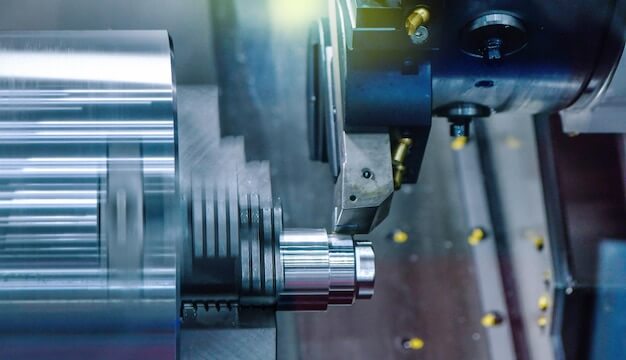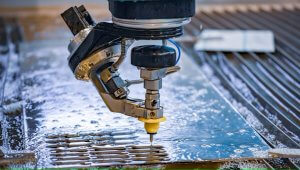CNC Machining in Aerospace: An Introduction and Overview
Computer Numerical Control (CNC) machining is a manufacturing process that utilizes software-directed machines to fabricate complex parts with high accuracy and repeatability. Being able to program the machine’s movements allows for precise control, enabling a level of detail that would be difficult to achieve manually. This characteristic is especially important in the aerospace industry where component design complexities are on par with safety-critical performance requirements. CNC machining has relevance for producing aviation components from different materials such as titanium and aluminum alloys, each having unique considerations. For example:
- Titanium, known for its exceptional strength-to-weight ratio and resistance to heat, is often utilized for critical structural components within the aircraft.
- Aluminum, while not as strong or heat-resistant as titanium, is significantly lighter, making it an ideal choice for elements where weight reduction is crucial without compromising too much on strength.
In this context, understanding material properties and their respective processing nuances becomes paramount when deciding which one to use in specific aerospace applications.
aluminum cnc machining service
Understanding Aerospace Materials: Titanium vs Aluminum Alloys
In the aerospace industry, selecting the right materials for different applications is crucial to ensure maximum safety and efficiency. High among those typically selected are titanium and aluminum alloys.
Titanium, characterized by its high strength-to-weight ratio and superior corrosion resistance, becomes a popular material in many aerospace constructions. Key properties of titanium include lower density than steel but almost equal in terms of strength, high melting point, excellent high-temperature stability, and remarkable resistance against most acids and alkalis. For instance, aerospace engineers often use titanium alloy Ti-6Al-4V due to its exemplary fatigue resistance in wing structures and jet engines components.
Moving onto aluminum alloys, these offer unique benefits as well. Notably, they present excellent strength-to-weight ratios, good fracture toughness, and exceptional machinability. These attributes make them ideal choices for aircraft skin, fuselage, and engine components. An example use case within the aerospace sector is in the construction of commercial airplanes where series 2024 and 7075 aluminum are used extensively thanks to their combined characteristics of high strength and light weight.
Advantages and Disadvantages of Using Titanium for CNC Machining in Aerospace
- Titanium offers exceptional strength-to-weight ratios, corrosion resistance, and biocompatibility, making it suitable for aerospace components and biomedical applications.
- However, titanium is expensive, difficult to machine, and has poor electrical conductivity, which can impact its suitability for certain aerospace applications.
Pros and Cons of Utilizing Aluminum Alloys in CNC Machining for Aerospace
In the realm of aerospace manufacturing, aluminum alloys are valued due to their lightness and flexibility. For instance, Boeing’s 747 commercial airplanes utilize an enormous percentage of aluminum components to reduce weight and improve fuel efficiency. However, despite its benefits, using aluminum can also invite certain drawbacks. One significant disadvantage is that aluminum lacks the strength provided by another popular aerospace material, titanium. This was highlighted in 1988 when cracks were discovered on the wings of the Aloha Airlines Flight 243 made predominantly from aluminum; a stark reminder of the potential risks involved with this material choice.
- Strengths: Lightness and flexibility make aluminum ideal for reducing aircraft weight and increasing flight efficiency. A specific example is it’s usage in commercial airplanes like Boeing’s 747.
- Weaknesses: Compared to titanium, aluminum has significantly lower strength which can increase safety risks. The cracking issue faced by Aloha Airlines exposes this downside, pointing out the need for robust material selection strategies.
Comparative Analysis Between Titanium and Aluminum Alloys for CNC Machining in Aerospace Applications
In choosing a material for CNC machining in aerospace applications, several factors distinguish titanium from aluminum alloys. Both materials have their pros and cons, hence the need for careful consideration before making a choice.
| Titanium | Aluminum Alloys | |
|---|---|---|
| Strength | High Strength to weight ratio | Moderate strength but lighter than Titanium |
| Cost | More costly due to extraction and processing methods | Cheaper and more readily available |
| Corrosion Resistance | High Corrosion resistance particularly to saltwater | Affected by corrosion but can be coated for protection |
| Thermal expansion | Lower thermal expansion, hence stable at different temperatures | Higher rate of Thermal expansion which could affect part accuracy |
Therefore, when picking between aluminum alloys and titanium for CNC machining, it is paramount to consider factors such as the application’s requirements for strength and durability, the project budget, and any potential issues related to corrosion or heat exposure. For instance, while titanium offers superior strength and corrosion-resistance, its high cost may not always justify its use, especially if the component will not be under intense stress or subjected to corrosive environments. Conversely, while aluminum alloys may require additional protections against corrosion and are less stable at high temperatures, their low cost and light weight may make them a more practical choice for certain applications.
Related Posts
- CNC Machining for Aerospace: Titanium vs. Aluminum Alloys Comparison
CNC Machining in Aerospace Industry: Material Choice Significance CNC machining, an abbreviation for Computer Numerical Control machining, is a process utilized extensively in the aerospace sector. The technology relies on…
- CNC Machining for Aerospace: Titanium Alloys vs. Aluminum - Performance and Cost Analysis
CNC Machining in the Aerospace Industry: An Introduction and Importance of Material Selection CNC (Computer Numerical Control) machining is a manufacturing process where pre-programmed computer software directs the movement of…
- The Advantages of Using LSR (Liquid Silicone Rubber) in CNC Prototyping and Production?
Introduction to LSR in CNC Prototyping and Production The utilization of Liquid Silicone Rubber (LSR) in CNC prototyping and production has been growing exponentially due to its numerous advantages. For…








